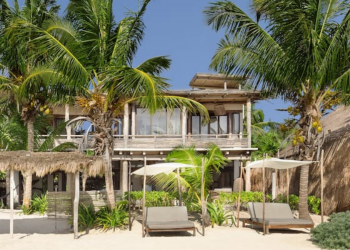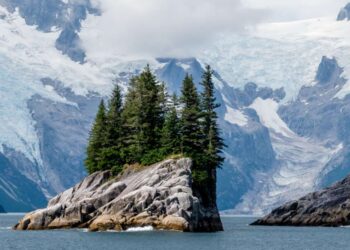Powdery white sand fringed by aquamarine water and towering palms is certainly the traditional beach-color palette. But plenty of color-sand beaches across the globe stray from these pigment parameters. Among the most colorful beaches in the world: pale pink, fiery orange, red, purple, and yes, even black.
The variance in hue is caused by the unique mineral compensation of rocks and materials in the area where the sand originates, as well as nearby erosion. Iron-rich minerals, for example, create a stunning red or brown hue; corals and shells, a pale pink; while black-sand beaches are most often the result of nearby volcanic activity.
All are stunning. From the Bahamas to Australia, following are our favorite, most colorful beaches in the world.
Pink Sand Beach: Harbour Island, Bahamas

The aptly named Pink Sand Beach, located on Bahama’s tiny Harbour Island, is literally named for its gorgeous rose-colored hue. Seductively stunning — especially in contrast to the surrounding aquamarine sea — this 3.5-mile, pink-champagne beach is surprisingly never crowded, although don’t be surprised to see model and fashion shoots in action.
When To Visit
We recommend penciling in your pink sand beach vacation between December and April, which is considered the Bahamas’ “Dry Season.” You’re less apt to run into gnarly weather (including hurricanes) and there’s more going on. If you prefer thinner crowds, aim for the shoulders.
Things To Do
In addition to penciling in tons of time at the beach itself — where you can comb the beach for pink coral and enjoy water sports and horseback riding — take time to explore Harbour Island’s quaint villages. You’ll find eateries, boutique shops, and historic sites such as Loyalist Cottage and St. John’s Anglican Church.
Insider Tip
Note that a lot of photographers adjust the saturation settings in their pictures of Pink Sand Beach so that the coastline appears as a very dark or bright pink. This is a bit misleading since the pink tones are more mild in person. The beautiful colors often look more vibrant at sunrise or sunset.
Pfeiffer Purple Sand Beach: Big Sur, California

For a glimpse of a rare purple sand beach, take California’s scenic coastal highway to Big Sur. It sounds strange, but try to plan your visit for a foggy day or following a storm, which is when the violet deepens to an even dark plum. Pfeiffer Beach’s purple sand comes from manganese garnet that has eroded from the surrounding hills and washed down to the sea.
When To Visit
If you’re in it to see this unique beach sand color, plan your trip during the winter months of November, December, and January. At this time of year, the angle of the sun is positioned lower in the sky, which allows the light to interact with the manganese garnet particles in a way that enhances the purple coloration. This effect is particularly noticeable during sunrise and sunset when the sun’s rays are slanting across the beach. (Bonus: fewer crowds.)
Things To Do
Unlike typical beach resorts, Pfeiffer Beach is a rockier terrain that lends itself more to adventurous activities versus pure beach lounging. (This is especially true if you visit in winter). Check out the captivating sea caves and rock arches, sculpted by the ocean waves, and explore the tide pools along the shoreline where you’re apt to come across sea anemones, crabs, and small fish.
Insider Tip
Check out the tide times before your visit. Some of the unique rock formations and sea caves are only accessible during low tide, while exploring tide pools and sea caves is only possible when the tide is low.
Kokkini Red Sand Beach: Santorini, Greece

Santorini’s stunning Kokkini Beach is a red sand beach that draws its name from the steep red cliffs that dip down to the sea’s edge. The unique red sand color occurs due to the iron-rich, black and red lava rocks that once spewed from Thiria, the island’s ancient volcano.
When To Visit
The spring months of April through June are considered an ideal time to visit this beautiful red sand beach. Temperatures are mild, crowds are moderate, and the surrounding landscape is lush. If you prefer warmer water, aim for July or August. The crowds are thicker, so try to arrive early in the day.
Things To Do
Swimming and snorkeling are top priorities at this beach thanks to the unique underwater landscape and vibrant marine life. If you’re feeling adventurous, explore some of the nearby red and black volcanic rock formations, or schedule a boat tour that involves cove and beach exploration.
Insider Tip
Beaches here are not as silky as other beach vacations you may be used to. Plan accordingly with proper footwear (water shoes are advised) and practice caution when walking near the cliffs.
Papakolea Green Sand Beach: Naalehu, Hawaii

Green sand beaches are very rare, which makes them absolutely worth the trek. That’s definitely true for Papakolea Green Sand Beach, also known as Mahana, located at remote Pakolea Beach on Hawaii’s Big Island. Olivine crystals (which are the color of olives) found in lava rocks gives this colorful beach its striking green color. Papakolea is a two-hour drive from both Hilo and Kona, and involves a two-mile hike to reach the emerald-colored sand.
When To Visit
Pencil in your vacation to this gorgeous green sand beach between April and October. The weather is more temperate and predictable this time of year, which ensures you can get more out of your vacation.
Things To Do
Scout for a secluded, welcoming cove and spend time swimming and wading in the water. You can also comb the beach for olivine crystals, enjoy some local hiking (which promise some epic scenic views), and check out the tide pools for a better glimpse of local marine life.Porto Ferro: Sardinia, Italy
Insider Tip
There’s some hiking involved in order to get to this beach. If you’re not digging the exercise, consider hiring a four-wheel drive vehicle. If you decide to hike, note that the trail is sandy and uneven, so proper footwear is a must.
Porto Ferro Orange Sand Beach: Sardinia, Italy

The fiery orange sand beaches of Porto Ferro, located on Sardinia’s northern corner, are the kind that make you do an involuntary double take and jaw drop. This unusual pumpkin color is created by the area’s rusty orange limestone, crushed shells, and other volcanic deposits. The result is a spellbinding colorful beach experience you’ll never forget.
When To Visit
Spring and fall are ideal times to visit this orange sand beach thanks to great weather and thinner crowds. The high season is summer — when the weather is very sunny and warm — but the beaches are quite crowded and local accommodations are pricier and apt to be sold out at the last minute.a
Things To Do
Porto Ferro is known for its surf-perfect waves, making it a popular spot for both newbie surfers and veterans of the sport. Also spend time strolling the shoreline to find natural treasures and interesting rocks, and to observe local marine life and birds.
Insider Tip
While Porto Ferro Beach itself is well-known, don’t shrug off hidden coves and smaller beaches nearby. Some of these coves might require a short hike or a bit of adventurous exploration, but the reward is often a quieter and more private space to enjoy the beauty of the Mediterranean.
Black Sand Beach: Reynisfjara, Iceland

While Hawaii is certainly famous for numerous black-sand beaches, a non-tropical alternative comes courtesy of Iceland’s Reynisfjara Beach, located near the village of Vik. The sand is actually a collection of glossy black rocks, formed from black lava, which offers a dramatic setting especially when paired with the rugged cliffs and pounding waves.
When To Visit
Iceland is chilly year-round but skews warmer (and greener) in spring and summer. The days are also longer during this time of year, which gives you more time to explore. Winter often comes with snow and ice, which can make driving trickier and exploring more of a challenge.
Things To Do
Iceland is a veritable outdoor wonderland, and the same rings true for Reynisfjara Beach. Take time to marvel at the basalt columns, which were formed by the cooling and cracking of lava. Also check out the sea stacks, located just off the coastline. Dep[ending on the time of year, you may be able to spot seabirds, including puffins, around the cliffs and stacks. (Puffins are most commonly seen from mid-May to August.)
Insider Tip
Reynisfjara Beach isn’t really one for swimming. In fact, the waves can be somewhat dangerous, so always follow current safety rules. There’s plenty to do out of the water, though.
Rainbow Beach: Queensland, Australia

Located on Australia’s Sunshine Coast, Rainbow Beach is made up of 72 different colors of sand. While scientists contend the varying shades come from the cliffs’ rich mineral content, Aboriginals say that a rainbow fell from the sky onto the beach.
When To Visit
Weather in Rainbow Beach is great all year due to the subtropical climate. However, peak tourist season is during the Australian summer (December to February), and lends clear skies, warm temperatures.
Things To Do
Take a walk to the Carlo Sand Blow, a large sand dune that overlooks the ocean and offers an epic view of this colorful beach’s vibrant sand formations. Also consider dolphin feeding, fishing, or visiting nearby Great Sandy National Park to get some hiking in.
Insider Tip
If you’re keen on whale watching, visit between July and October, which is when you’re most likely to see the majestic humpback (even from the shoreline). A whale watching boat tour is another great way to spend the day.
Ocean Cape Gray Sand Beach: Yakutat, Alaska

For shades of gray, head to Alaska’s Ocean Cape area near the remote town of Yakutat (population 700), to find miles of gray sand littered with twisty driftwood. The gray beach is part of Tongass National Forest, and sits adjacent to Glacier Bay National Park and Preserve.
When To Visit
June through August is considered the peak tourism season for Ocean Cape. Weather is mild and the days are longer, which makes outdoor activities more enjoyable. If you prefer a quieter and more serene visit, though, aim for September and October. Avoid winter and be wary that Spring may still be quite cold and harsh.
Things To Do
Ocean Cape boasts diverse wildlife, offering glimpses of marine life — including whales and seals — from the cliffs. If you fancy yourself a bird watching enthusiast, you’ll enjoy observing various seabird species that inhabit the region. Adventurers can pencil in time for hiking and exploring (pack and dress accordingly), and those who prefer to take it easy can consider some glorious star peeping come nightfall.
Insider Tip
One thing to note is that Ocean Cape is pretty remote and therefore requires more up-front planning. Accessibility might be limited due to weather conditions and the lack of infrastructure, so double check weather forecasts and road conditions.
Feature image courtesy of Veruree Apisitamornkul, iStock







